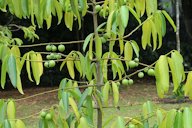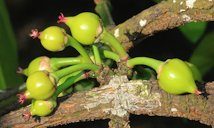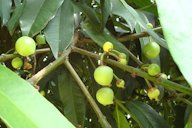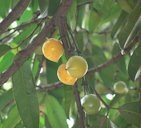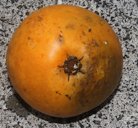| Gamboge, False mangosteen - Garcinia xanthochymus | |||||||||||||||||||||||
|---|---|---|---|---|---|---|---|---|---|---|---|---|---|---|---|---|---|---|---|---|---|---|---|
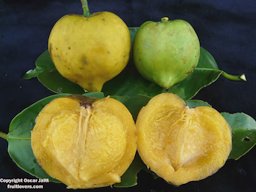 Fig. 1  Gamboge fruit 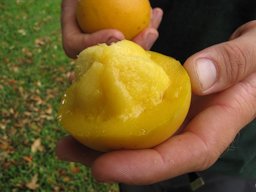 Fig. 2  Garcinia xanthochymus (yellow mangosteen, false mangosteen, gourka). Fruit. Hamana Pl Haiku, Maui, Hawai'i. 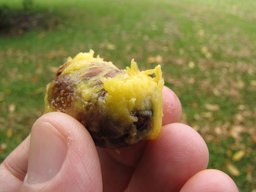 Fig. 3  G. xanthochymus. Seed nibbled on. Kahanu Gardens Hana, Maui, Hawai'i. 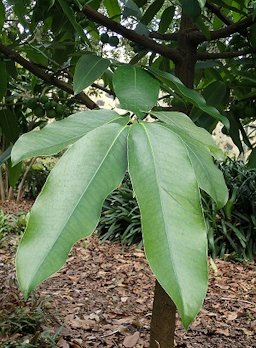 Fig. 4 G. xanthochymus in Jardín de Aclimatación de la Orotava 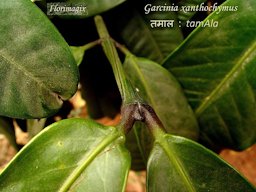 Fig. 5  Glossy, leathery leaves opposite, the stalks meet in a V shaped node, slightly bulky and clasping the stem. The stem is longitudinally striated and older ones have fissures. 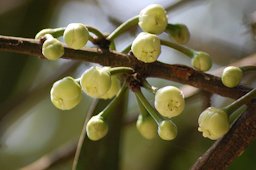 Fig. 11  Flowers of G. xanthochymus, Clusiaceae, native to India but rarely seen in cultivation 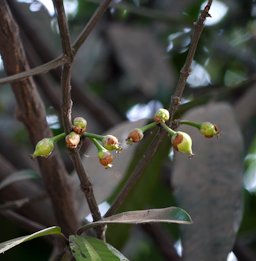 Fig. 12  G. xanthochymus fruit forming 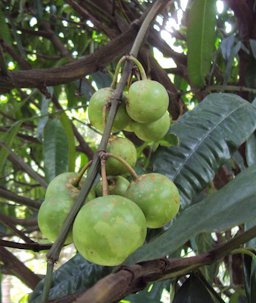 Fig. 13  Unripe fruits are hanging from a false mangosteen aka gamboge (G. xanthochymus) tree in the Mounts Botanical Garden, West Palm Beach, Florida  Fig. 14  G. xanthochymus fruit, persistent staminode column 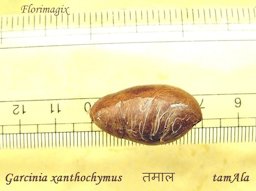 Fig. 21  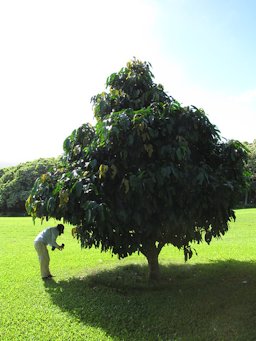 Fig. 22  G. xanthochymus, tree habit 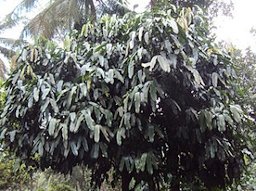 Fig. 23  Growth habit  Fig. 24  Tree form 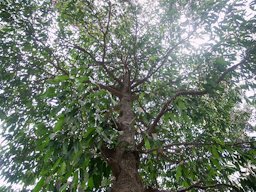 Fig. 25  G. xanthochymus, Thane, India  Fig. 26  Bark |
Scientific
name Garcinia xanthochymus Hook. f. ex T. Anderson Common names English: mysore gamboge, yellow mangosteen, eggtree, gamboge tree, sour mangosteen, Himalayan garcinia, false mangosteen; Burmese: daungyan, dawyan-ban, hmandaw, madaw; Chinese: Da Ye Teng Huang; Czech: garcínie Žlutá; French: gamboge des teinturiers, mangoustan amer; India: dampel, tezpur, tepur yenga; Malaysia: asam kandis, kandis; Portuguese: gamboge, mangostao-amarelo, falso-mangostin; Thailand: mada luang (Chiang Mai), mada (Northern), chakasa (Karen); Sri Lanka: cochin goraka, kolon, jamala, rata goraka (Sinhala); Vietnamese: bứa nhuộm 7 Synonyms G. pictoria (Roxb.) Engl.; G. tinctoria W.Wight; G. tinctoria (DC.) Dunn; Stalagmitis pictoria G.Don; Xanthochymus pictorius Roxb.; X. tinctorius DC. 6,7 Family Clusiaceae/Guttiferae (St. John’s wort family) Origin Tropical Asia from India to Malaysia 10 USDA hardiness zones 11-12 Uses Fruit Height 26-33 ft (8-10 m) tall; trunk 6-18 in. (15-45 cm) in diam. 5 Crown Dense pyramidal crown 2 Plant habit Extraordinary pyramidal shaped canopy; slow rate of growth3,9 Trunk/bark/branches Bark gray-brown; hard, heavy, coarse-grained wood with many knots; branches horizontal; twigs distinctly angled 3,5,7 Leaves Evergreen; leathery; oblong to lance shaped; hang down from the branches 2 Flowers Small, greenish white; male and androgynous on axillary fascicles 2 Fruit Oblong or ovoid berry type; smooth; yellow; 1-3 seeds; succulent pulp, sweet with little acidity 2 Season Mar.-May Light requirement Sun or part shade Soil tolerances Light (sandy), medium (loamy) and heavy (clay) soils; prefers well-drained soil; can grow in nutritionally poor soil 9 pH preference Prefers 6-7.5, tolerates 5.5-8 Cold tolerance Damage temp. 32 °F (0 °C); killed 28 °F (-2 °C) Invasive potential * None reported Garcinia species from the Americas were once classified as Rheedia, but now all are considered Garcinia. Sorting Garcinia Names, Multilingual Multiscript Plant Name Database, University of Melbourne, Australia ext. link Origin Garcinia xanthochymus is native to northern India. The genus Garcinia contains 250 species with a center of diversity in the Old World. This species was introduced into hawai'i by Albert Jaeger in 1900. 1 Garcinia xanthochymus originated probably from India and Burma. It occurs in the wild, growing in the hills of South India and can also be found widely distributed in the hill forests of the Eastern Himalayas and hence the common name ‘Himalayan garcinia'. Description It is a tropical fruit species that occurs as under-storey tree in the dense humid forests of valleys or on hills from 100 to 1,400 m altitude. It is adapted to a moist, shady environment and well-drained soils rich in humus and organic matter. 7 The tree requires a humid tropical to warm subtropical climate and is rarely grown outside tropical Asia except in botanical gardens and rare plant collections. 8 Gamboge is a wide-spreading species with enormous, drooping leaves and globose, apple-sized, golden yellow fruit. 3 Leaves/branches Branches numerous, slender, decussate, horizontal but usually distally pendulous, twigs distinctly angled (Fig. 8,9,10). Petiole robust, V-shaped and somewhat clasping at base, 0.6-1 in. (1.5-2.5 cm), angled and transversely wrinkled when dry, those of terminal 1 or 2 pairs on branchlet usually rose-colored; leaf blade shiny, elliptic or oblong to oblong-lanceolate, 8-13 x 2.4-4.8 in. (20-34 x 6-12 cm), thickly leathery, mid vein robust, raised on both surfaces; veins dense, to 35–40 pairs, near margin arching and anastomosing; tertiary veins and veinlets conspicuous, base broadly cuneate, margin involute, apex acute to obtuse, rarely acuminate. Corymbose cyme 5–10 flowered, arising from leafless axils; peduncle 0.3-0.5 in. (6-12 mm). Pedicels 0.7-1.2 in. (1.8-3 cm). 5
Fig. 6. G. xanthochymus leaves, Hamana Pl Haiku, Maui, Hawai'i Fig. 7. G. xanthochymus in Jardín de Aclimatación de la Orotava, leaf growth habit Flowers The flowers are unisexual meaning that the ovule and pollen producing structures are borne on separate flowers and in this species are borne on different trees. The pollen producing flowers have five petals and many stamens on which the pollen is produced that are arranged in bundles each containing five stamens. The ovule producing flowers also have stamens but they are non-functional or sterile therefore they produce no pollen. 1 Fruit The fruit is golden yellow, globose with a stout stalk, five persistent sepals and a woody point obliquely placed on the lower side, which is the remnant of the coherent bundle of staminodes. 5 Seeds, the largest 1.2 in. (3 cm), others frequently seen undeveloped; are embedded in the flesh and attached to it by a thin fibrous mesh, the endocarp which can be easily pulled away. The seed coat itself is smooth glossy brown, patterned. Upon drying it peels off like a peanut skin to reveal a white firm seed (Fig. 20). 4
Propagation By seed and by grafting. 2 Food Uses Garcinia xanthochymus is cultivated extensively in Southeast Asia for its fruit or as a substitute for tamarind in curries and other typical Asian dishes. The fruits are sometimes fermented to produce vinegar. 8 The pleasant acid fruit flesh can be eaten fresh, preserved or made into sherbets or jams, and curries. The young shoots are edible and have a sour taste. The fruits are also cooked and eaten. 7 In India, young leaves are considered edible and eaten raw, cooked as spinach or added to a curry. 3 Other Uses The yellow mangosteen is used as a rootstock for grafting purple mangosteen (G. mangostana). 8 The term “gamboge” is also used to describe a resin extracted from the bark of the Garcinia tree. It is used as a premium yellow dye for textiles and paint. At one time, it was used to dye the robes of Theravada Buddhist monks and is still used to dye silks and other materials. The trees of the Gamboge fruit are only one of several species used for this pigment, some more intensely colored than others. The substance was first introduced to the United States in the late 1800s and was referred to as Siam Gamboge. Siam is the former name for Thailand. 11 Other Edible Garcinia species: Achachairu, G. humilis Bacuripari, G. macrophylla Bakupari, G. brasiliensis Cherapu (button mangosteen), G. prainiana Imbe (African mangosteen), G. livinstonei Lemon Drop Mangosteen, G. intermedia Madrono, G. madruno Gamboge Botanical Art List of Growers and Vendors |
||||||||||||||||||||||
| Bibliography 1 Staples, G. W., and D. R. Herbst. "A Tropical Garden Flora: Plants cultivated in the Hawaiian Islands and other tropical places." Honolulu, Hawai’i, Bishop Museum Press, 2005, ntbg.org/database/plants/. Accessed 23 June 2017. 2 Lorenzi, Harri, et al. Brazillian Fruits & Cultivated Exotics (for consuming in natura). Nova Odessa, Instituto Plantarum de Estudos da Flora, 2006. 3 Barwick, Margaret. Tropical & Subtropical Trees. A Worldwide Encyclopaedic Guide. London, Thames & Hudson Ltd. 2004. 4 Florimagix. "Garcinia xanthochymus." Wikimedia Commons, commons.wikimedia.org. Accessed 22 June 2017. 5 Xiwen, Li, et al. "Clusiaceae, Garcinia xanthochymus." Flora of China, Missouri Botanical Garden Press, St. Louis., Vol. 13. 2007, flora.huh.harvard.edu/china/. Accessed 23 June 2017. 6 "Garcinia xanthochymus synonyms." The Plant List (2010), Version 1, theplantlist.org. Accessed 22 June 2017. 7 Lim T. K. "Garcinia xanthochymus." Edible Medicinal And Non-Medicinal Plants: Volume 2, Fruits, EPDF, 2012, epdf.pub/volume-2-fruits.html. Accessed 2 June 2021. 8 Blancke, Rolf. "Garcinia xanthochymus." Tropical Fruits and Other Edible Plants of the World: An Illustrated Guide, Zlibrary, 2016, b-ok.cc/book/3414166/f1bf9d?dsource=recommend. Accessed 2 June 2021. 9 Fern, Ken. "Garcinia xanthochymus." Plants For A Future, PFAF, pfaf.org/user/Plant.aspx?LatinName=Garcinia+xanthochymus. Accessed 2 June 2021. 10 "Gamboge, also called Yellow Mangosteen, Garcinia xanthochymus." The Rare Fruit Club WA, www.rarefruitclub.org.au/Gamboge.htm. Accessed 3 June 2021. 11 "Gamboge fruit." Murray Family Farms, Specialty Produce, www.specialtyproduce.com/produce/Gamboge_Fruit_15575.php. Accessed 3 June 2021. Photographs Fig. 1 Jaitt, Oscar. "Garcinia xanthochymus, False Mangosteen." Fruitlovers, fruitlovers.com. Accessed 31 Jan. 2015. Fig. 2 Starr, Forest and Kim."Garcinia xanthochymus (Yellow mangosteen, false mangosteen, gourka). Fruit in half. Kahanu Gardens, Hana, Maui." Starr Environmental, 2012, (CC BY 4.0). starrenvironmental.com. Accessed 31 Jan. 2015. Fig. 3 Starr, Forest and Kim. "Garcinia xanthochymus (Yellow mangosteen, false mangosteen, gourka). Seed nibbled on. Kahanu Gardens Hana, Maui, Hawai'i." Starr Environmental, 2012, (CC BY 4.0), starrenvironmental.com. Accessed 22 June 2017. Fig. 4,7 Krzysztof Ziarnek, Kenraiz. "Garcinia xanthochymus in Jardín de Aclimatación de la Orotava." Wikimedia Commons, 2016, (CC BY-SA 4.0), commons.wikimedia.org. Accessed 22 June 2017. Fig. 5,14,21 Florimagix. "Garcinia xanthochymus." Wikimedia Commons, 2016, (CC BY-SA 4.0), commons.wikimedia.org. Accessed 22 June 2017. Fig. 6 Starr, Forest and Kim. "Garcinia xanthochymus (Yellow mangosteen, false mangosteen, gourka). Leaves. Hamana Pl Haiku, Maui, Hawai'i." Starr Environmental, 2014, (CC BY 4.0), starrenvironmental.com. Accessed 22 June 2017. Fig. 8,10 Cerlin Ng. "Garcinia xanthochymus." Flickr, 2014, (CC BY-NC-SA 2.0), www.flickr.com. Accessed 22 June 2017. Fig. 9 Machado, Siddarth. "Garcinia xanthochymus. India." Flickr, 29 Jan. 2014, (CC BY-NC 2.0), www.flickr.com/photos/siddarthmachado/15910847422. Accessed 2 June 2021. Fig. 11 jayeshpatil912. "Flowers of Garcinia xanthochymus from Clusiaceae. Native to India but rarely seen in cultivation." Wikimedia Commons, 2012, (CC BY-SA 2.0), commons.wikimedia.org. Accessed 30 Jan. 2015. Fig. 12,18 Valke, Dinesh. "Garcinia xanthochymus, tree growth habit, Thane, India." Wikimedia Commons, 2012, (CC BY-SA 2.0), commons.wikimedia.org. Accessed 22 June 2017. Fig. 13,23 Vinayaraj. "Garcinia tinctoria." Wikimedia Commons, 2012, (CC BY-SA 3.0), commons.wikimedia.org. Accessed 30 Jan. 2015. Fig. 15,17 Cerlin Ng. "Garcinia xanthochymus." Flickr, 2015, (CC BY-NC-SA 2.0), www.flickr.com. Accessed 22 June 2017. Fig. 16,24,26 Kwan. "Garcinia xanthochymus." The Plant Observatory, 2009, natureloveyou.sg. Accessed 31 Jan. 2015. Fig. 18,25 Valke, Dinesh. "Garcinia xanthochymus, Thane, India." Wikimedia Commons, 2007, (CC BY-SA 2.0), commons.wikimedia.org. Accessed 22 June 2017. Fig. 19,20 Cerlin Ng. "Garcinia xanthochymus." Flickr, 2016, (CC BY-NC-SA 2.0), www.flickr.com. Accessed 22 June 2017. Fig. 22 Starr, Forest and Kim. "Garcinia xanthochymus (Yellow mangosteen, false mangosteen, gourka). Tree habit. Kahanu Gardens NTBG Kaeleku Hana, Maui." Starr Environmental, 2009, (CC BY 4.0), starrenvironmental.com. Accessed 31 Jan. 2015. * UF/IFAS Assessment of Non-native Plants in Florida's Natural Areas Published 30 Jan. 2015 LR. Last update 12 Dec. 2023 LR |
|||||||||||||||||||||||



